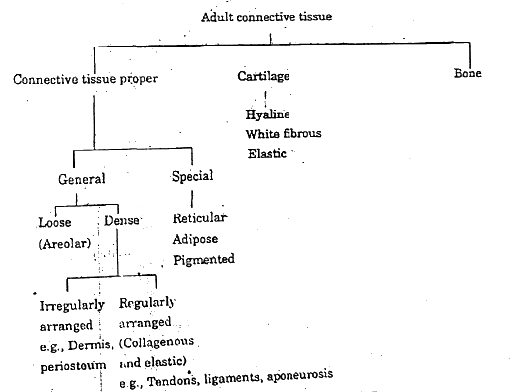Tissues and their Classification | Animal Husbandry & Veterinary Science Optional for UPSC PDF Download
Tissues and it's Types
Cells and Tissues:
- In multicellular organisms, cells group together to form functional tissues.
- Tissues cooperate to create complex structures called organs.
- Cells within tissues are in contact with an extracellular matrix, which helps hold them together and provides a framework for cell interaction.
Types of Tissues:
- Connective and epithelial tissues are two main types with distinct structures and functions.
- Connective tissues have a matrix that bears mechanical stress, while epithelial tissues consist of tightly bound cells forming protective sheets.
Epithelial Tissues:
- Line body surfaces and cavities, creating barriers against the movement of substances.
- Rest on a supporting bed of connective tissue.
- Types include simple columnar, stratified squamous, and transitional epithelium.
Connective Tissues:
- Fill spaces between organs and tissues.
- Composed of tough protein fibers (collagen and elastin) in a gel-like matrix.
- Two categories: embryonic (mesenchyme and mucous) and adult (connective tissue proper, cartilage, and bone).
Functions of Connective Tissues:
- Provide mechanical support.
- Allow tissues to stretch and recoil.
- Participate in the repair and regeneration of tissues after injury.
Glandular Epithelium and Neuroepithelium:
- Glandular epithelium secretes substances.
- Neuroepithelium is involved in nervous system functions.
Connective Tissue Components:
- Fibroblasts secrete extracellular matrix, mainly collagen and elastin.
- Osteoblasts contribute to bone formation.
- Adipose cells make up fat tissue.
Repair and Regeneration:
- Epithelial tissues have a remarkable capacity for repair.
- Three types of epithelial cells: absorptive, ciliated, and secretory.
In Simple Terms:
- Our body is made up of different cells that work together to form tissues and organs.
- Connective tissues provide support and help with repair, while epithelial tissues protect surfaces.
- Different types of tissues have unique functions, such as lining body surfaces or supporting organs.
- Cells within tissues have specific roles, like absorbing, secreting, or protecting.
Key Takeaway: Understanding how our body is organized at the cellular and tissue levels helps in appreciating how different parts work together to keep us healthy.

Loose Connective Tissue (Areolar Tissue):
- Found throughout the body, it creates the framework for blood vessels and nerves, filling small spaces.
- Comprises cells, fibers, and ground substance.
Dense Connective Tissue:
- Fibers closely packed to form sheets, cords, or bands.
Blood Tissue:
- Consists of free cells and fluid (plasma).
- Components include red blood cells (carry oxygen), white blood cells (defend against infections), and platelets (help in clotting).
Muscle Tissue:
Produces mechanical force through contraction.
Three main types: skeletal (moves joints), smooth (found in organs), and cardiac (heart muscle).
Skeletal muscle: Strong and rapid contraction, bundled into muscle fibers.
Smooth muscle: Present in digestive tract, bladder, arteries, and veins; not striated.
Cardiac muscle: Intermediate, responsible for the heartbeat, linked by electrically conducting functions.
Nervous Tissue:
Specialized for receiving, transforming, and transmitting stimuli as nerve impulses.
Central Nervous System (CNS): Brain and spinal cord.
Peripheral Nervous System (PNS): Cranial and spinal nerves.
Nerve cells or neurons are communication specialists.
The brain and spinal cord consist of neurons and supporting cells.
Axon conducts electrical signals away from the cell body.
Schwann cells or oligodendrocytes wrap around the axon, forming a protective sheath.
Key Takeaway: Understanding different types of tissues—loose and dense connective tissues, blood, muscle, and nervous tissues—helps us appreciate their roles in supporting, moving, and communicating within the body.
Embryonic and Adult Tissues
1. Embryonic Connective Tissue:
- Made up of mesenchymal and mucus connective tissue.
- Mesenchyme is unspecialized tissue in the embryo, disappearing as the body develops.
- Serves as a temporary stage, precursor to various tissues like cartilage, bone, blood, and muscle.
- Mucus connective tissue is found in the umbilical cord, known as Wharton's jelly.
2. Adult Connective Tissue:
- Includes areolar, dense white fibrous, elastic, reticular, pigmented connective tissues, adipose tissue, and the reticulo-endothelial system.
3. Repair and Regeneration:
- Epithelial tissue can repair through cell division, especially for minor injuries.
- Connective tissue has significant regenerative power, playing a crucial role in wound healing. Granulation tissue forms during regeneration.
- Cartilage regeneration is slow, and in some cases, it may not occur. Bone tissue can regenerate and repair.
- Smooth muscle has limited regenerative capacity, skeletal muscle regeneration is restricted, and adult heart muscle has minimal regenerative ability.
- Nervous tissue faces challenges: if nerve cell body dies, there is no replacement; however, nerve fibers can regenerate proximal to the injury.
Key Takeaway: Understanding different tissues in the body, from embryonic to adult, helps us appreciate their roles in development, repair, and regeneration. While some tissues have strong regenerative capabilities, others face limitations, especially in the nervous system.
FAQs on Tissues and their Classification - Animal Husbandry & Veterinary Science Optional for UPSC
| 1. What are the different types of tissues? |  |
| 2. What is the difference between embryonic and adult tissues? |  |
| 3. How are tissues classified? |  |
| 4. What is the function of epithelial tissue? |  |
| 5. What is the role of muscle tissue? |  |




















